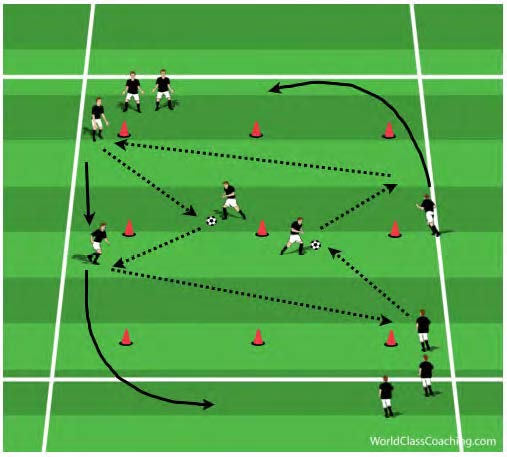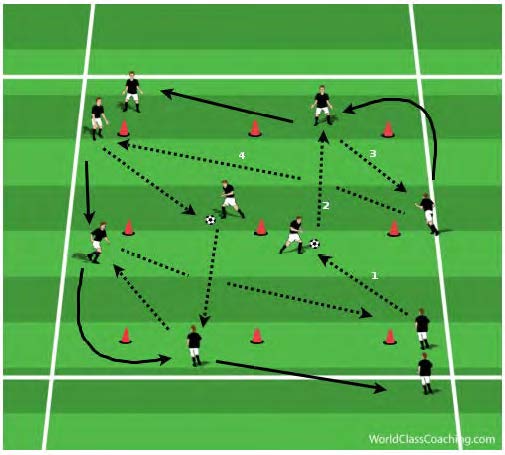WORLD CLASS COACHING
Soccer Intelligence
By Jason Carney
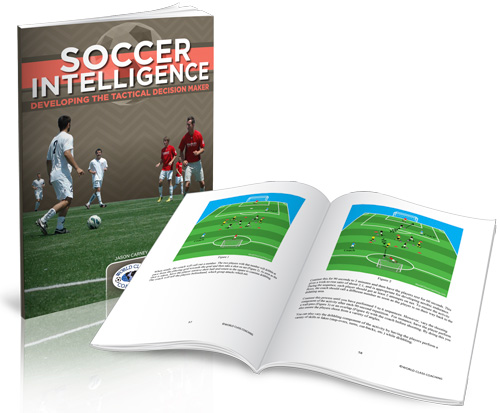
TABLE OF CONTENTS
Part Two
TECHNICAL PRACTICE - PASSING AND BALL CONTROL
Technical practice sessions - The foundation
Passing and ball control
Q. Is passing a part of tactical training?
A. Yes. The tactical purpose of passing is to keep possession.
Passing should be used more than any other skill. Passing encourages team-work and creates the team bonding you need to become a successful group. Your tactics should involve passing, so passing is a part of tactics. The exercises must be practiced at the highest speed possible, as long as you do not allow the quality to suffer.
Players need frequent repetition to stabilize the technique at a high level. With frequent repetition, the exercises have to be engaging to the player. A player will not keep up their enthusiasm if the exercises are boring and not challenging. A great way to do this is to try and incorporate shooting as one of your variations to the passing exercise. All players love shooting. It involves optimal concentration, precision, intensity and competition. It will also allow your goal keepers to get some quality practice time.
The key points to a good passing exercise are:
• Accuracy
• Weight
• Timing
• The decision to make the pass
Players have to understand these four key aspects of passing and the exercises used at your practice sessions must encourage the players to do this.
Accuracy – Does the player with the ball pass the ball to feet or into space?
Weight – Each pass must have a certain speed to have the correct execution.
Timing – The correct moment to make the pass. Your players will understand the “feel” of timing by conducting practices that are related to timing.
The decision – The player on the ball will have to be aware of the movement and positioning of the opponent and be willing to change their decision.
The following passing exercises are an alternative to your warm up program and the advantages for your team will be clear to see.
• Players are now being monitored by the coach and their team-mates.
• Players have to be fully focused right from the start.
• The challenging warm up puts the players mind in a mentally prepared state. This should have an effect on the rest of the practice session.
Plan a topic - Explain to the players before the practice session starts about the topic you are working on and what you want to achieve by the end of the session. If the topic is attacking, play numbers up so that you can achieve success. If you get the success with playing numbers up, then go to equal teams. Defending topics can work effectively with equal teams or even playing a player down, depending on the quality of player.
The key is to work on exercises that are about your topic. Fitness will be part of your session planning, whether it’s with a ball or without. We can do a better job in warm ups. Players should not be sent around the field to dribble their ball. If jogging is needed, players learn to warm themselves up, as a team. Speed, agility and quickness exercises are also essential to the player’s development.
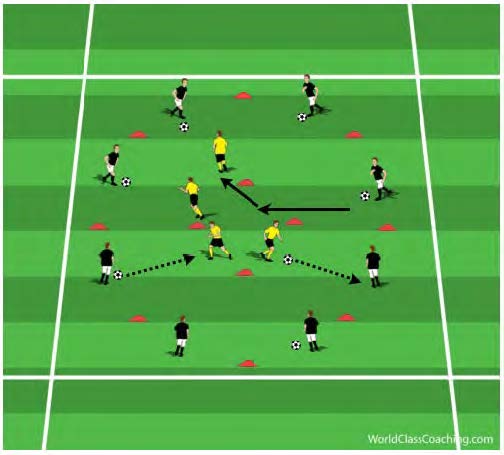
Controlling the ball with the correct surface
Exercise:
Area – One large circle with a smaller circle in the center. Size is suitable for the age and ability of the players
• Have two equal groups. The players on the outside have a soccer ball.
• Players in the center circle do not have a soccer ball.
• The coach explains the control and pass required:
1. Players control the ball with the inside of the foot and pass it back.
2. Control the ball with one foot across the body, and pass with the opposite foot.
3. One touch pass back.
4. Chest control and pass if appropriate.
5. Once they perform the exercise, they MUST go back into the center circle, and then come out again and receive a pass.
6. All passes are passed back to the server.
Variation:
• Players on the outside take legal throw-ins instead of passing. Player receives the ball and passes back to the thrower’s feet.
Coaching points:
Communication. Enthusiasm. Intelligence – after making a pass, and players are moving back into the center circle, they scan around the field to see who’s open.
Quality ball control and passing.
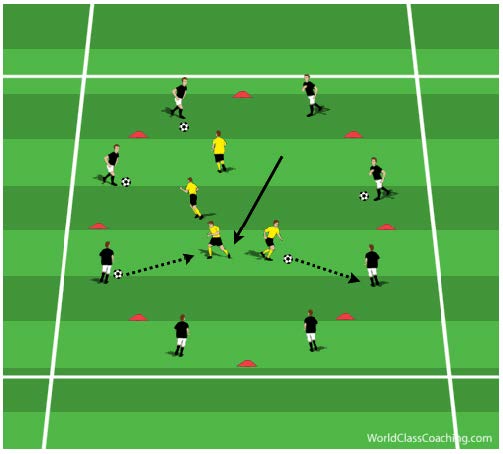
Controlling the ball with the correct surface – Variation
Exercise:
• Area – Same as the previous set-up, but take out the center circle and leave three / four players inside the circle. • Always have one more ball than the number of players in the middle on the outside.
1. Players in the center receive a pass from the outside.
2. They CANNOT pass to the player who passed them the ball. They take their first touch with an open body position, and pass to a player on the outside who does not have a soccer ball.
3. Throw-ins can also be used by outside players. (Legal throws)
Variation:
• Put players in two’s in the middle of the circle. Nominate a player from each pairing who receives the pass from the outside, and the other player in the twosome passes the ball to an open outside player. Players on the outside now pass to the designated player from each pairing, who passes to their partner, who then passes to the outside.
Coaching points:
• Communication. Enthusiasm. Intelligence – before receiving a pass, players scan around the field to see who’s open to receive the next pass. Think ahead.
• Quality ball control and passing.

Details of passing – The Y drill
Exercise:
• Area: The set up uses four cones and is shaped like the letter “Y”. The cones are 15 yards apart. To start, players are placed in positions A,B,C,D & E. All the players at position A, have a soccer ball.
1. Player A passes to player B. Player A has to be aware of passing to the correct foot.
2. Player B, who is shadowed by player C opens up their body and takes a quality first touch. As soon as the first touch is executed, player D makes a forward run.
3. Player B passes the ball into the space for player D to collect and player D returns to the start.
4. Rotation: A to B, B to C, C to D (or E), D or E to the start.
5. The exercise is now run with a pass to the other side, player E.
Coaching points:
• Players be aware of where the next pass is going. Pass the ball accurately to the correct foot.
• Players have to be prepared to move quickly to receive a poor pass.
• Energy and enthusiasm.
• Receive on the back foot with an open body shape.
• Passing – Accuracy, weight and timing.
• Timing of the run from the wide player.
• Communication.
Details of passing – The Y drill - Variations
Variation #1
• Player A passes to player B. Once player B turns with tight ball control, he/she plays a give and go with wide player D.
• The same rotation applies.

Variation #2:
• Player A passes to player B. Player B drops the ball back to player A who passes long to player D. Player D now plays a give and go with player B. Now work the other side.
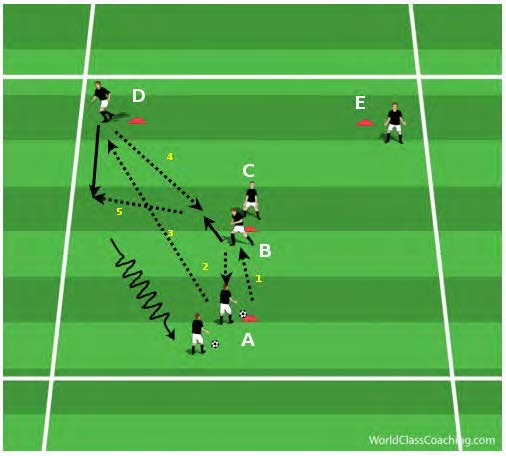
Coaching points:
• Quality movement. The timing of the movement is so important. This gives the players a valuable understanding of the movement needed.
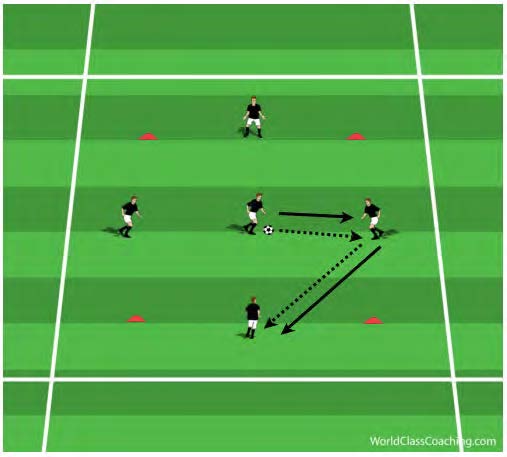
Passing and moving
Exercise:
• Area – 20 x 20. Five players and one soccer ball.
• Central player starts the exercise. He / she passes to an outside player and follows the pass.
• The outside player, with an open body, takes a touch and passes to any other player and follows the pass..….and so on.
Coaching points:
• Intelligence, Body shape, Enthusiasm
• First touch, Passing & Moving
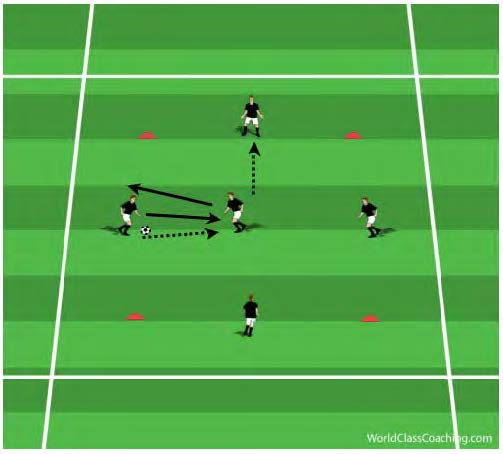
Passing and moving - Variation
Exercise:
• Area – 20 x 20. Five players and one soccer ball.
• Outside player starts the exercise. He / she passes to the middle player. He / she then follows the pass.
• The middle player, with an open body takes a good first touch and passes clockwise to the next outside player.
• The middle player now moves to the space that was occupied by the player who passed them the ball.
Now ask the players to go counter clockwise.
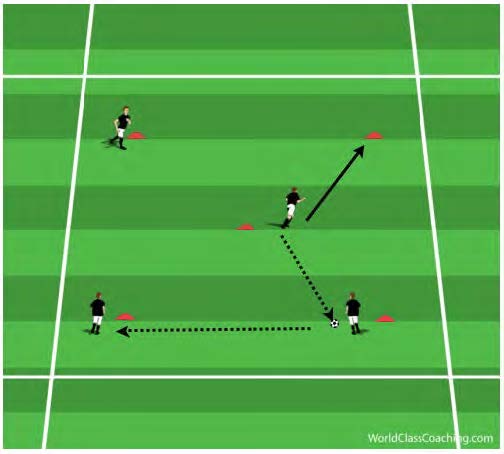
More passing and moving
Exercise:
• Area – 15 x 15 with a cone placed in the middle of the grid. Four players and one soccer ball.
• A player starts the exercise. He / she passes to any player and moves to the empty space.
• The receiving player, with an open body, takes a touch and passes to any other player and moves to the empty space..….and so on.
Variation:
• Add a passive defender so the players get the feel of moving off the ball while there is a defender present.
Coaching points:
• Try and not run across the path of the ball
• Intelligence, Body shape, Enthusiasm
• First touch, Passing & Moving

Passing and movement off the ball - Advanced
Exercise:
• Area: 20 x 40.
• Exercise shows 10 players with one soccer ball. (Can be done with more players or run two stations)
• Two players are placed in the central area.
1. Player A passes the ball to the first central player and continues his / her run.
2. Player B moves forward and receives the pass from the middle player. He / she then passes the ball to the next middle player who passes to the running Player A. Player B joins the opposite group.
3. Player A now passes to the end player. The exercise now goes the other way in the same passing sequence.
Variations:
• Change the middle players.
• Add two balls. One at each end. The quality has to be good for this to work. The middle players have to be alert.
• Get Players A & B to make diagonal runs instead of straight.
Coaching points:
• Timing of runs.
• Quality of passing.
• Movement.
• Middle players checking to the ball.
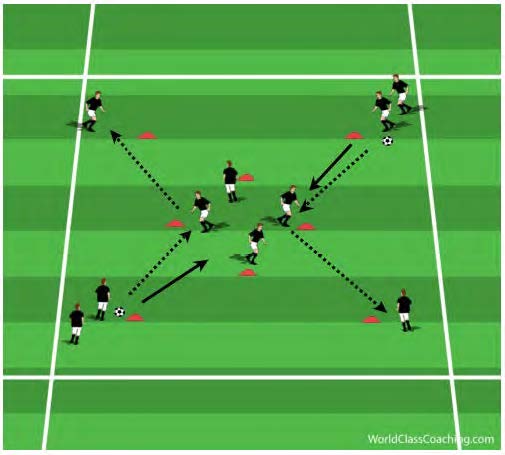
Details of passing – Receive on the back foot
Exercise:
• Area: 25 x 25 with 4 cones placed at an angle in the middle of each line (as shown)
• The exercise shows 10 players starting with two soccer balls. (Can be done with more players)
• The ball is passed clockwise.
1. The two balls are passed at the same time.
2. Play starts with a pass to the central player who opens up his body, receives with the back foot, (Right foot) and passes to the next player.
3. All players take a quality first touch behind the cone, pass and follow the pass.
4. Clockwise – Players on the inside open up and receive the ball with their RIGHT foot. Outside players take their first touch with their LEFT foot. Counter clockwise – Players on the inside open up and receive the ball with their LEFT foot. Outside players take their first touch with their RIGHT foot.
Variations:
•Add a third ball. Maybe a fourth ball if more than 10 players are in the group or the quality of the player is at a high level?
Coaching points:
• Pass the ball accurately to the correct foot.
• Players have to be prepared to move quickly to receive a poor pass.
• Energy and enthusiasm.
• Receive on the back foot with an open body shape.
• Passing – Accuracy, weight and timing.
• Communication.
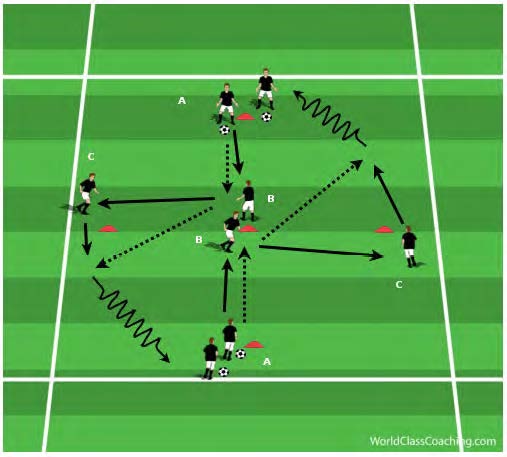
Timing of the pass and run
Exercise:
• Area: Set up in the shape of a cross. Cones are 15 yards apart in the shape of a cross.
• Exercise shows 8 players. (This can be done with more players)
• Set up the players as shown above with the starting payers at position A each having a soccer ball.
1. Player A passes the ball to player B and then follows his/her pass.
2. Player B receives on the back foot with an open body shape and passes the ball to the wide running Player C. Player C times his/her run and receives the ball.
3. Player C now dribbles to the starting group.
4. Player A moves to the Player B position and Player B moves to Player C.
5. Change passing direction.
Coaching points:
• Pass the ball accurately to the correct foot or space.
• Receive with an open body.
• Timing of pass / run.
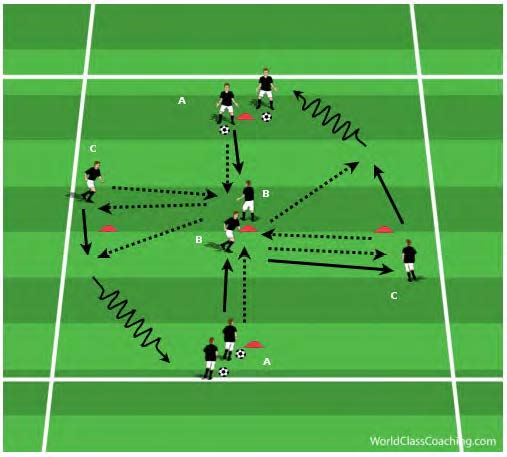
Timing of the pass and run - Variation # 1
Variation # 1:
1. Once player B receives the ball, player C moves off the cone to receive the ball at his/her feet.
2. Player B plays a pass to player C who plays a give and go with player B.
3. Player B now passes the ball into the space for player C to collect. Player C joins the opposite group.
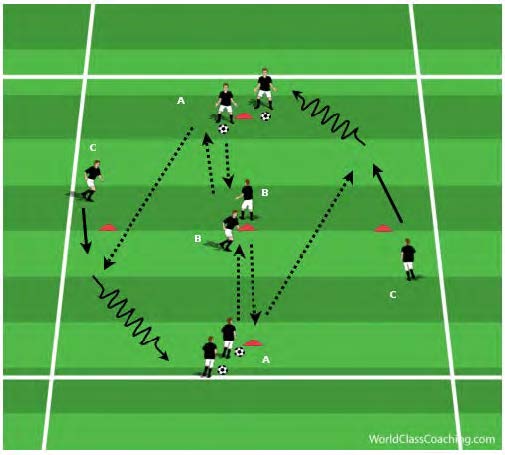
Timing of the pass and run - Variation # 2
Variation # 2:
1. Player A passes to player B.
2. Player B drops the ball back to player A who plays a through ball for Player C to run onto.
3. The weight of the pass and the timing of the run are key coaching points.
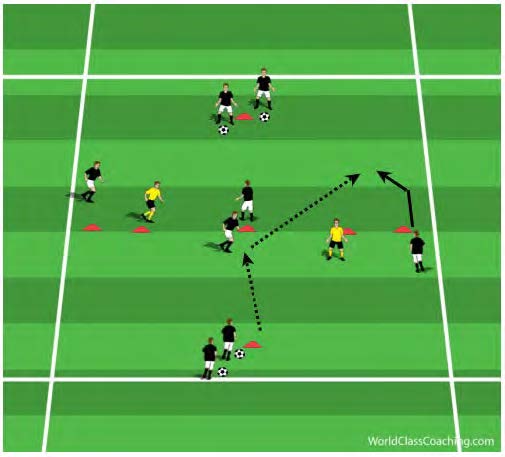
You can add another player to the exercise as shown above to act as a defender.

Breaking the offside
Exercise:
• Area: Half of a playing field.
• Exercise shows 7 players and a goalkeeper. (This can be done with more players)
• Set up the players as shown
1. Player passes the ball to the middle player and follows his/her pass.
2. Middle player receives on the back foot with an open body shape and passes the ball behind the defender to the wide player. Wide player times his/her run to stay on side.
3. Player shoots at goal and then joins the starting group.
4. Player rotate to the next cone.
5. The next pass from the starting group is passed to the left. The same sequence is performed.
Variations:
• The variations from the passing exercises (from page 27 & 28) can be used in this shooting drill.
Coaching points:
• Pass the ball accurately to the correct foot or space.
• Receive with an open body.
• Timing of pass / run.
• Stay on-side.
• Shot at goal.
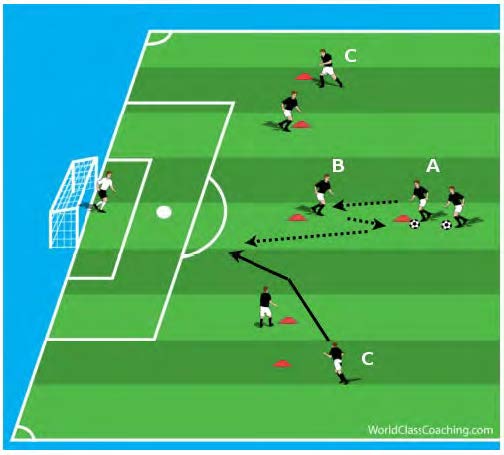
Breaking the offside - Variation
• Move the outside cones wider. Player A passes to B and player B passes back to player A. Player A passes to the wide runner, player C. Player C makes an inside run in front of the defender.
Coaching points:
• Pass the ball accurately to the correct foot or space.
• Receive with an open body.
• Timing of pass / run.
• Stay on-side.
• Shot at goal.
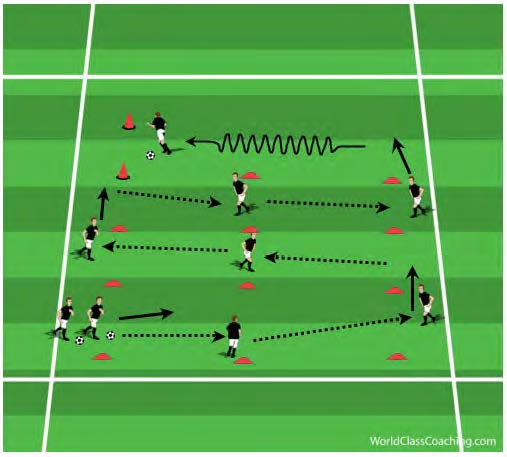
Details of passing – Two touch passing - Advanced
Exercise:
• Area: Three 5 x 24 channels with all players at the start with a soccer ball (as shown)
• The inside central player receives the ball on the back foot. The outside player, with their first touch, moves the ball into the next channel.
1. Starting player passes the ball to the correct foot of the next player and follows the pass.
2. Central player receives the ball on the back foot and passes to the correct foot of the outer player, and follows the pass.
3. Outer player takes a first touch into the next channel and passes to the next player and follows the pass.
4. Once the final player of the group receives the ball, they move the ball wide and run with the ball through the gate and then joins the starting line.
Coaching points:
• This is a two touch passing exercise.
• Pass the ball accurately to the correct foot.
• Players have to be prepared to move quickly to receive a poor pass.
• Energy and enthusiasm.
• Receive on the back foot with an open body shape.
• Passing – Accuracy, weight and timing.
• Communication.
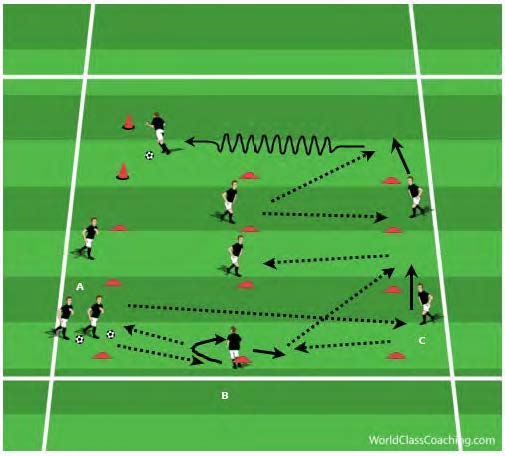
Details of passing – One touch passing - Variation
Exercise:
• Area: Three 5 x 24 channels with all players at the start with a soccer ball (as shown)
1. Starting player A passes the ball to the correct foot of player B who plays the ball back one touch to player A.
2. Player A passes the ball one touch to player C.
3. Player B now supports player C. Player C passes one touch to player B and then moves to the next channel.
4. Player B passes to player C and player C now starts the same passing sequence in the next channel.
5. After passing the ball, players move to the next position.
Variations:
• You can add a goal instead of a gate at the end. Players take a shot at goal and then rejoin at the starting position.
Coaching points:
• This is a one touch passing exercise. Quick give and go’s
• Pass the ball accurately
• Players have to be prepared to move quickly to receive a poor pass
• Timing of the support run. Do not get there early
• Passing – Accuracy, weight and timing
• Communication

First touch - Breaking the lines
Exercise:
• Area: 15 x 15 with four gates as shown above. 8 - 10 players with 2 soccer balls.
1. The two starting players pass the balls clockwise.
2. Receiving player takes a quality first touch through the gate, then passes to the next player.
3. After passing, players follow the pass.
3. Change direction and pass counter clockwise. The gates will have to be changed. See if your players can work it out?
Coaching points:
• Pass the ball to the correct foot
• Receive the ball on the back foot
• Quality first touch
• Open body shape
• Quality passing – Accuracy, weight and timing of the pass
• Communication
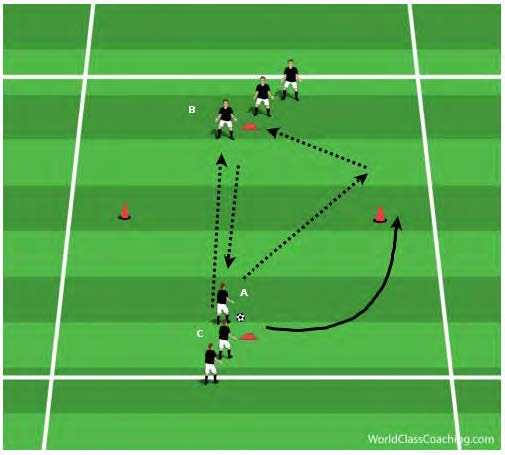
Third man running
Exercise:
• Area – players are 40 yards apart. Two cones are in the middle 30 yards apart (as shown)
• Player A passes to player B and then makes an overlapping run around one of the cones.
• Player B passes back to player C and then joins position A. Player C passes passes the ball to running player A.
• Player A passes to the next player in position B and then follows the pass.
• Repeat the passing sequence.
• Players decide which outside cone they want to overlap.
Overlaps
Exercise
Area –– 30 x 20 (split in two channels of 10 x 30.) Two groups, each group has one ball. Two players stand in the center facing one group.
• The starting player passes to the central player and then goes on an overlapping run. The central player checks to the ball and opens up his / her body, receives the ball on the back foot and passes the ball in front of the overlapping player..
• The overlapping player then passes to the next player in the opposite group and follows the pass.
• Rotate the central plays every few minutes.
• Move the groups to the other side of the grid to work on the opposite foot.
Coaching points:
• Enthusiasm, intelligence and energy
• Overlap at full speed
• Timing of the pass and run
• Communication
• Body shape of receiving players
• First touch
Overlaps with third man running - Variation
Exercise
• Same set-up as overlaps but add one player at each end line as shown above.
• The starting player passes to the central player and then goes on an overlapping run. The central player checks to the ball and opens up his / her body and receives the ball on the back foot.
• On receiving the pass, the central player passes the ball long to the player on the end line. The end line player passes to the overlapping player who passes to the next group.
• The end line player moves to join the next group and the overlapping player moves to the end line.
• Rotate the central plays every few minutes.
• Move the groups to the other side of the grid to work on the opposite foot.
Coaching points:
• Overlap at full speed
• Timing of the pass and run
• Communication
• Body shape of receiving players
• First touch
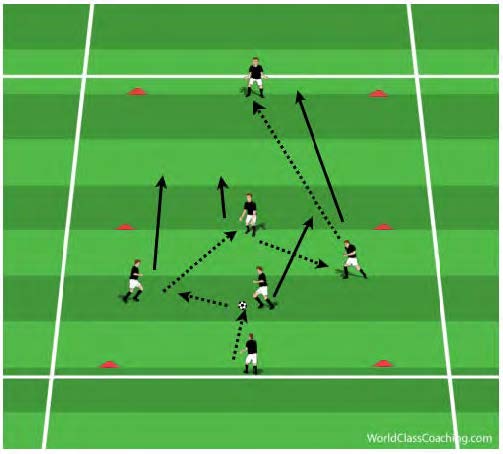
Transition warm up
Exercise
• Playing area is two 15 x 15 boxes with 6 players and one soccer ball.
• One player is positioned on each end line.
• Every player has to touch / pass the ball. The last person to receive the ball passes the ball long to the player on the opposite end line.
• All four players now move into the opposite playing area. The player who passed the ball to the end line player, swaps positions. The end line player who has just received the ball passes to one of the incoming players who start the same passing sequence.
• Every player has to touch / pass the ball. The last person to receive the ball passes the ball long to the player on the opposite end line.
Variation:
• Add a defender
Coaching points:
• Quality of passing
• Intelligence to make the correct pass
• Body shape of the receiving players
• Communication

